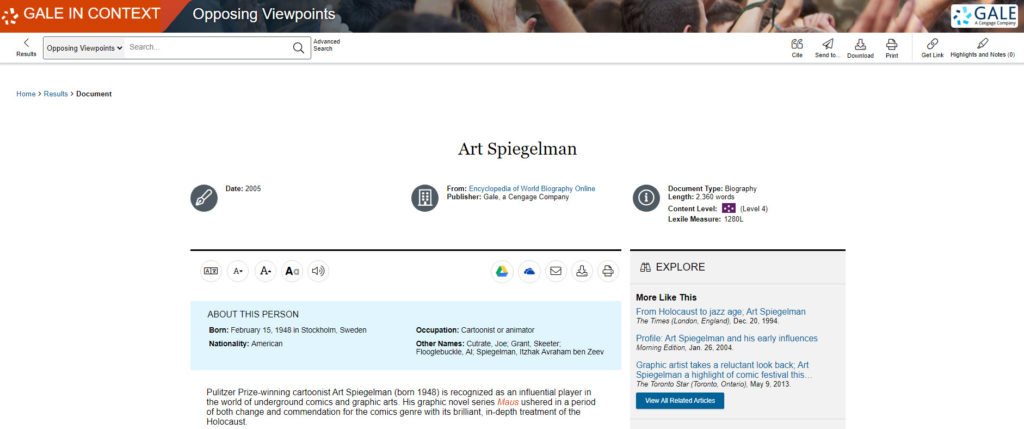Explore the issue within Gale In Context: Opposing Viewpoints
| By Durf Humphries |
Gale In Context: Opposing Viewpoints recently updated the Book Banning portal with new content. However, restricting or banning books, including comic books, is nothing new. Since comic books began to gain popularity in the first half of the twentieth century, many people have dismissed them as an art form and accused them of corrupting young minds.
In January 2022, the McMinn County School Board in eastern Tennessee voted to remove Art Spiegelman’s 1986 graphic memoir, Maus, from school curriculum. Maus has earned praise, including the first and only Pulitzer prize awarded to a graphic novel, for its unique and emotional ways of exploring difficult topics. The book discusses the author’s parents’ experiences during the Holocaust and his mother’s suicide later in life.
Despite the work’s reputation, the board voted unanimously to ban Maus, citing the use of profanity and the nonsexual depiction of nude characters. The announcement was criticized by educators, activists, and authors from around the country. Nirvana Comics, a comic book shop in nearby Knoxville, Tennessee, offered free copies of the book to any student, upon request.
Though the banning of Maus caught the nation’s attention, comic books continue to face an uphill battle for mainstream acceptance as valuable educational resources. Since 1990, the American Library Association’s Office for Intellectual Freedom has collected data about book challenges and bans. Comic books, including Alison Bechdel’s Fun Home and Dav Pilkey’s Captain Underpants series, regularly appear on the annual lists of most-challenged books.
The most notorious challenge that comic books ever faced occurred in the 1950s, as parents and educators became concerned about the impact of comics on young minds. In 1954’s Seduction of the Innocent, psychiatrist Fredric Wertham claimed that comic books contributed to juvenile delinquency and other societal ills. The publication of Wertham’s book coincided with the U.S. Senate Subcommittee on Juvenile Delinquency launching an inquiry into the effects of comic books on young people.
The panic surrounding comics in the 1950s led to the creation of Comics Code Authority, a regulatory body created by the comics industry that prohibited creators from including certain sexual elements, disrespect for authority, drug use, and vampires, among other things. This practice of self-censorship influenced most of the mainstream comics produced in the United States for subsequent decades. Even stripped of their salacious elements, comics struggled to gain recognition as a valid art form and tool for education.
Published in the 1980s, Maus found itself on shelves with other comics that tried to elevate the medium. Alternative comics, like the Hernandez brothers’ Love and Rockets, attracted new audiences to graphic storytelling. In the field of superhero comics, creators such as Frank Miller and Alan Moore explored new types of stories that disregarded the content restrictions that had dominated the medium. The Comics Code Authority lost its influence over time, with every comics publisher abandoning it by 2011.
In the late twentieth and early twenty-first centuries, changes in the production and distribution of comics enabled more creators to use sequential art to express their ideas. The graphic memoir became a popular and powerful way for people to tell their stories. Marjane Satrapi has given readers a unique look at Iranian culture through her works, including Persepolis, which has faced its own bans. In the 2010s, civil rights leader John Lewis and actor and activist George Takei helped tell difficult chapters of U.S. history through March and They Called Us Enemy, respectively.
Comics provide an accessible medium for creators to tell stories that can inspire, encourage empathy, and educate audiences in ways that other types of storytelling can’t. This power has proven intimidating to those who wish to keep these books away from readers. Comic books can help readers build on what they know and enrich their understanding. As part of the larger debate over freedom of expression, comic books, even the black-and-white ones, make the conversation more colorful.
Encourage your students to explore this contentious issue—as well as hundreds more—within Gale In Context: Opposing Viewpoints.
For more information about the controversy around Maus, as well as other frequently banned books, see Gale In Context: High School.
About the Author
Durf Humphries is deputy editor at Bookbright Media, a producer of educational and academic content, and he has worked with Gale/Cengage products since 2016. He taught at several universities in China, including his service as a Peace Corps volunteer. An avid comics reader and weekly science fiction trivia contest host, Durf lives in Atlanta, Georgia, with his wife and two wonderful cats.



